June 26, 2010
See also:
EULOGY
of Roy H. Bible
by
Bill Stevens
and this
Note of 2003
| In memory of Roy Bible
Rolf Tschudin (NIH) averted me about the recent (April 19) departure of Roy H. Bible Jr., an NMR old-timer and Author of the popular 1965 book Interpretation of NMR Spectra: An Empirical Approach (Plenum Press). I did not know him but I did use the book quite a lot in late 60's and 70's. He is also the Author of a very recent book, A Guide for Selecting Nmr Techniques which, after having been postponed by a year, was slated to come out this month. I have contacted the Publisher (VCH) to see whether it will be indeed released but did not receive any answer yet. I hope it will.
Replying to my query, Rolf writes:
... he spent most or all of his career at GD Searle & Company (Physical Methodologies Dept, Skokie, Illinois, USA) and yes, the book you mentioned is also his. Plus some more, and a bunch of papers. Had a trusty technician who appears on most of his publications, Elisabeth Hajdu. My personal acquaintance with the two goes back to many pleasant conversations at a number of ENC's. Since I am a pusher of electrons I can not comment on the actual value of his work, but it was hot stuff in the 60's when I started in the field. And he was a Character, full of life ...
May he spin happily forever
Note (1 July, 2010):
I have got a word from the Publishers that, unfortunately, the book A Guide for Selecting Nmr Techniques will not be published. It has been in limbo since many years and there is now no chance to finish it.
|
June 24, 2010
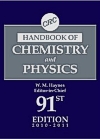
| 91st Edition of the CRC Handbook
The 91st Edition of the CRC Handbook of Chemistry and Physics, edited this time by William M. (Mickey) Haynes has just left the presses and reached the market. This is not specifically NMR news, but the importance of this historic and growing data collection for all scientists can not be downplayed - not even in this electronic age. After all, a database can not be better than the data it contains and, as far as reliability goes, these data are the best money can buy. Moreover, the money we are talking about is not much (no doubt thanks to the market volume). At about US$ 100, the tome is affordable even for me.
Since this entry is not NMR-specific, allow me to draw your attention to my lists of Physics Books and Chemistry Books. In chemistry, especially, there has been an extremely heavy publishing activity these days with a mighty stream of new monographs and new/reprinted textbooks hitting the bookshops. If your interests have anything to do with chemistry, you should have a look.
|
June 23, 2010
COMMENTS: 3
See ALSO ...
... and ALSO
| Half-integer nuclei?
This entry may [finally] reveal how dumb I really am, but I will risk it anyway.
I often read about this or that being done to/with high half-integer spin nuclides or, as Glenn Facey has just put it, half-integer quadrupolar nuclei. I have often lauded Glenn for the first-class educational work he is doing on his blog, and this article of his is no exception. He just should not have dropped the word spin from the title because the term half-integer nucleus does not make any sense. But an omission like that is understandable for an NMR professional; what bothers me is something else that goes beyond Glenn's article.
In solid-state NMR, the locution high half-integer spin is used mostly to refer to spin I = n/2 with n = 3, 5, 7, ... In his entry, Glenn specifically lists these values, but it appears to be a general attitude. Now, this beats me because, as far as I can see, nuclides with spin 2/2 (2H, 6Li, 14N) are subject to many of the phenomena associated with the high half-integer spin category and those with spin 6/2 (10B), 8/2 (40K), 10/2 (138La), 12/2 (50V), and 14/2 (176Lu) exhibit all of them (there is no known stable nuclide with spin 4/2, but that is just an accident).
It is possible that something essential which differentiates between odd n and even n (other than the plain value) is missing in my education. I am aware that nuclides with odd n are fermions while those with even n are bosons which does affect a bit the thermodynamic properties of their ensembles and, through the way they couple to lattice motions, it can also affect spin isomerism in equivalent groups. Such effects, however, should be tiny and limited to very low temperatures; I am not aware of any appreciable role they might play in those routine solid-state NMR contexts where I nevertheless so often encounter the insistence on odd n. I would be therefore grateful to anyone willing to fill me up and, since some of my and Glenn's readers might be as uninformed as myself, I would gladly share that piece of knowledge with them.
Otherwise, if no compelling distinction between the odd and even n values exists, it might be better if we adopted the term high spin nuclides and reserved the half-integer locution for those rare cases where the fermion/boson distinction really matters.
COMMENTS:
26 June 2010: Stan
The discussion of this topic went on primarily on Glenn Facey's blog (see above) so, if you are interested, have a look. It essentially confirmed that I am in fact dumb :-( The fact is that for odd n in I = n/2, the two central energy levels corresponding to Iz = +1/2 and -1/2 do not contain any first order quadrupole contributions and therefore the transition between them is also void of them and is gets affected only by the second- and higher-order terms. In nuclides with even n, this applies only to the central level with Iz = 0 so that all transitions (remember: a transition involves two levels) are affected by the first order terms. This makes the difference between odd/even n.
Whether a signal under MAS conditions is observed or not is another story since there are exceptions in both categories: there are cases where even the second-order contributions for the central transition in half-integer spin nuclides are too large compared to achievable spinning rates, as well as cases where the first order contribution for integer-spin nuclides are reasonably small to detect meaningful MAS signals. In the end, it is the experiment that really matters!
I owe thanks to Melinda Duer, the Author and Editor of the excellent textbook Introduction to Solid-State NMR Spectroscopy (see the TOC), for setting me straight.
This discussion really combined two totally different topics. I still think that we often unwittingly slip into using an accolyte's jargon even when talking to broader audiences and/or students. Hence I insist that there are no "half-integer nuclides", just many "nuclides with half-integer spin".
15 July 2010: Glenn Facey
It is not quite correct. For a nuclide with n odd, the m=1/2 and m=-1/2 transitions are both affected by first order quadrupolar contributions. It is just that they are affected equally as the energy depends on the term (3m^2 - I(I+1)). Since they are affected equally, the transition between the two is unaffected to first order. In the case of nuclides with n even, the central energy level (m=0) is indeed affected by first order quadrupolar contributions. See pages 237-240 in Duer's book. Cheers, Glenn.
21 July 2010: Stan
Oops, you are right. To first order, the |+1/2> and |-1/2> energy levels ARE affected but the transition between them is NOT and, for quadrupolar nuclei, it is the only transition having this property. It is easy to slip when talking about levels while thinking transitions, or vice versa. For example, notice the first occurrence of the term "transitions" in your own last comment: you sure intended "levels" or "states" :-) But my error was worse than a simple slip ...
|
June 15, 2010
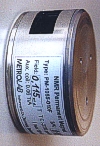
Field: 0.5 T
Weight: 1.2 kg
Diameter: 80mm
Gap: 13 mm
| Compact permanent magnets for time-domain NMR
Many of those reading this blog are spectroscopists or MRI buffs and possibly scoff the "simple" time-domain NMR applications (once called Low-Resolution NMR). But there are also many of us who dream building their own low-resolution, portable NMR system for any of the broad range of existing and potential time-domain NMR applications. A range which keeps growing faster than in traditional NMR spectroscopy (even disregarding the educational angle). In addition, there are those who would like to set up a small EPR spectrometer, and also those who have already built their own 4-20 MHz NMR system (field strengths 0.1 - 0.5 Tesla) around an old one-ton [electro]magnet keeps getting ever older and sucking up quite a bit of electricity and cooling water ...
This large and growing crowd might do well to have a look at the high-quality permanent magnets produced by the Swiss company Metrolab. They are small enough to hold them in a palm (ok, since they weigh around 1 kg, ladies with really delicate wrists should refrain from handling them) and they are produced in various field strengths up to 0.5 Tesla. Plus, they have almost no stray field and are very stable, very homogeneous, and come equipped with field-adjustment/modulation coils. They can accommodate NMR/ESR probes with the external width of up to 13 mm (the gap size is 13.5 mm), compatible with 8-10 mm probes without variable temperature or 4-6 mm with a full VT or other gear (shims, gradients, ...). The field is transverse, of course, suitable for solenoid coils.
The prices (max US$ 3500 or Euro 2900) do not necessarily match every hobbyist's dreams but, considering all the characteristics, they are definitely worth giving it a try (any experienced hobbyist will agree that a DIY approach, though more fun, is eventually bound to cost more and provide less in terms of specs).
Metrolab produces magnetic field measurement & plotting equipment for applications ranging from particle-physics beam-handling magnets to MRI and NMR magnet testing. They have initially developed the magnets described above as magnetic field metrology standards and only later noticed their potentially broader usefulness (this accounts for their compactness and stability).
|
June 8, 2010
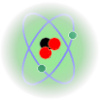
3He
Mass:
3.01602929 au
Abundance:
1.37 ppm
Spin:
1/2
Gamma ratio
-32.436 MHz/T
Current price:
8 - 50 k$/mol
| Dwindling 3He supplies
3He is one of the rare substances that can be fairly strongly pre-polarized and kept in that state for fairly long times (more about that some other time). Moreover, its nuclides have spin 1/2 and a pretty large magnetic moment. Since it is also physiologically inert, it is used in MRI to study the pneumatics of lungs. All kinds of clever MRI arrangements have been thought up to measure how lungs become less efficient when the alveoles get punctured by smoking or illness or plain old age. Not really Amazing Science, but so far so good, you might say, were it not that (a) helium-3 is already terribly expensive, (b) its supplies are dwindling and (c) it will probably very soon become unavailable at any cost, full stop.
To understand what's going on, have a look at the article "DOE begins rationing helium-3" by David Kramer which appeared in the latest issue of Physics Today.
Since what we are interested in is the number of nuclei present in a sample, I have converted the reported prices to per-mol units. Thus the present cost in the US (400 $/liter which is 4 times more than last year) converts to about 8800 $/mol (6700 Euro/mol), compared to that of gold which is presently 8300 $/mol (6300 Euro/mol). These prices are guaranteed (?) by the DOE (US Department of Energy), but just for the current year and for a limited range of applications: cryophysics below 1 K, lasers for missile and satellite guidance and, thankfully, MRI of the lungs (but not MRI in general!).
With the US reserves of 3He rapidly dwindling, what remains is becoming inaccessible to would-be customers outside the US, including the IAEA (International Atomic Energy Agency). Consequently, shady and black markets are already blooming in Europe and elsewhere, probably propelled by Russion reserves which "disappeared" from the official market in 2008. Institutional customers in the EU have already payed as much as 47000 Euro/mol and were glad to get it.
All this is paradoxically due to the otherwise beneficial worldwide shrinkage in nuclear weapons stockpiles. Nuclear weapons contain tritium which decays into 3He and must be replenished every 5 years or so and, in that occasion, the rare helium isotope is recovered. This harvesting of nuclear weapons was so far the principal source of helium-3 and the "supply" exceeded demand until about 2001 when the US stockpiles have peaked at 200000 liters (over 9000 moles). But the supply started decreasing ever since due to the reductions in nuclear weapons stockpiles, while the demand kept rising sharply due to new applications, such as compact neutron radiation detectors at security check-points (each contains 0.1 liters of 3He) and, of course, the MRI of the lungs. Alternative sources include the tritium that forms in water-cooled nuclear reactors (potential new producers: Canada and China) and the 1.37 ppm (IUPAC 2001) of 3He present in "normal" helium gas (see my 2008 entry). In both cases, however, setting up proper production facilities might take years and, even if these possibilities were fully developed, their combined capacity might still not cover the projected demand.
In view of all this, if you are considering any MRI or NMR research involving 3He, think twice! I am sure that in absolute majority of cases there are viable alternatives. Xenon-129 might be a better choice for hyper-polarized studies (it is costly, too, but its supplies are guaranteed), and plain 19F NMR with freons has always been the poor man's alternative.
|
June 1, 2010
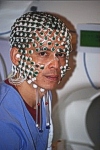
EGI's EEG cap
MRI compatible

EEG - fMRI
First hyphenated
MRI book

CT - MRI
Side/Top view
| Hyphenated MRI
In laboratory NMR, hyphenated and hypernated techniques combining several different methodologies are nowadays a normality. I have written about them on this blog almost two years ago, but that was actually a very belated entry. Making rounds of the exhibition hall at the last ISMRM-ESMRM meeting, it dawned on me that now it is the turn of MRI to enter the hyphenated world.
Of course, there was always some interaction between MRI and other imaging and patient-monitoring methods. For example ECG signal were used to synchronize MRI scanning with heart beats already in early 80's. That, however, is not quite the same thing as what we see today with emerging techniques such as EEG - fMRI which collect simultaneous data streams from both an electro-encephalograph and a functional MRI system.
During my ISMRM stroll I have noticed at least three commercial Companies entering into this field (EGI, Brain Products and NeuroScan), not counting the large manufacturers like Siemens and GE who are certainly working on it but in a more reserved manner. I can imagine that the perspective of combining the two techniques must be extremely attractive to neurologists and, in particular, functional neurologists. Separately, the two methods are often not very conclusive since the data are a very raw description of something much more intricate and complex going on in the brain. Combining them together brings in the promise of a qualitative jump due to their mutual synergy. It is like coping with a metropolitan traffic being either blind or deaf - and then suddenly gaining both senses!
The technical challenges of merging EEG with MRI are considerable. One problem is just plain MR compatibility: evidently, the EEG gear must be totally free of any ferromagnetic components. This, however, is just a mild nuisance compared to the mutual run-time interference between the two methods. In particular, EEG is essentially a large set of ultra-sensitive electric sensors (up to 256 in some models) which are connected by hundreds of cables to a computer. Consequently, the EEG signals get terribly disturbed by induction from the strong and rapidly varying magnetic field gradients which are essential for the MR scanning. Minimizing the interference is not only an engineering problem; special software's are used to purge the EEG signals of any "residual" disturbances which can be still an order of magnitude larger than the EEG signals. It seems, however, that most of these problems have been [almost] overcome and presently the EEG - fMRI is, figuratively speaking, on the road towards the neurological clinics.
--------------------------
In general, any hyphenation can boost the discerning power of its component techniques (the software folks can't wait to put their hands on it), but also save valuable time and patient handling associated with the diagnosis process. Presently, a patient may have first a CT scan, then an MRI scan, and finally maybe an EEG scan, commuting between different hospital facilities and spending hours in waiting rooms and preparations. If all such imaging essays could be done in a single session, there would be a considerable saving in personnel and, at the same time, a dramatic increase in the diagnostic significance of the results.
It strikes me that, in particular, combining MRI and CT should not be technically too difficult. The CT hardware can be fitted into a relatively slim torus which can be made geometrically compatible with an MRI magnet. I can easily envision a co-axial system with a split-coil MRI magnet combined with a central CT torus, as well as an open-access U-shaped MRI magnet with a CT torus inclined at a variable angle (hopefully this preempts a few patents :-) The result would be superior combined images and, in many cases, reduction of the patient time and operative expenses by half. Both items certainly more than worth the higher cost of the machine. Never acquire separately (sequentially) data that can be recorded simultaneously (in parallel)!
|
May 29, 2010

Click and rap along
with Zach Powers,
the science-rapper.
Keep rapping,
Zach!
| Structural Biology Music Video with an NMR section
An interesting e-mail:
Hi Stan.
I just made and released to YouTube a video about structural biology. I was looking around at some blogs hoping to plug my video and came across yours. I haven't found many decent blogs concerning NMR, so it was a nice find to stumble across yours; its now on my feedreader. If you get a chance, check out my video and let me know what you think.
Cheers, zach, grad student, ming-ming zhou lab, mount sinai school of medicine.
Wow, Zach, I love it!
Excuse me for giving away your name, but you need not be shy - in NMR we have got serious Professors spinning their arms who would no doubt love to rap if only they knew how, and also ex drummers who badly miss the vibes.
And thanks for deeming my blog "decent", I take it as a compliment. Stan.
|
May 26, 2010
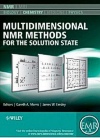
Gareth Morris
James Emsley,
Editors,
Wiley 2010.
See the TOC
| Exciting NMR Spectroscopy books
I should perhaps wait a bit with this entry since there are quite a few NMR books in the pipeline right now, but one of the two monographs that have just reached the market is simply too exciting. The tome, entitled Multidimensional NMR Methods for the Solution State, has been edited by Gareth A.Morris and James W.Emsley and published by Wiley (ISBN 978-0470770757). It costs $155 which may look a bit steep, but the book totals 540+ pages of eminently readable and yet rigorous and exhaustive articles written by the full Gotha of NMR spectroscopy. I have seen so far just a few pages and the Table of Contents, but I am already convinced that it is an exceptional editorial initiative which authoritatively covers a dominant area of modern NMR spectroscopy.
Since I could not find the Table of Contents neither on the Wiley web page, nor on Amazon, I have asked Jim Emsley to mail me a copy and I enclose it here. Check the Authors of the contributions and, if you know anything about NMR, you will also know why you must buy this book.
The other of the two monographs is the 2nd Edition of the immensely popular Understanding NMR Spectroscopy by James Keeler, published also by Wiley (ISBN 978-0470746097), which surely does not need any particular introduction. It is basically an excellent text for students which covers the whole of NMR spectroscopy, including 1D. Unless you already have the first Edition, you might be well advised to buy both these books for a very complete and up-to-date coverage.
|
May 24, 2010
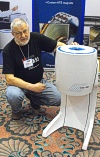
HTS-110
200 MHz CFSM
at the 51st ENC.
Click here
for a better view
of the model :-)
| Cryogen-free supercons knocking on MR doors
A year ago I wrote my first entry about cryogen-free superconducting magnets (CFSM). Since then, this technology was progressing at top speed, exploiting the relentless progress in availability, quality, and technological viability of high temperature superconductors (HTS).
I count at least six players in the field of CFSMs who are currently involved/interested in Magnetic Resonance. These include the big ones like Bruker (see their ETS venture), Varian (see their ex Magnex) and Jastec (the supplier of Jeol) who, unfortunately, tend to hold back on work-in-progress information. But there are also three more forthcoming and relatively new smaller Companies located in New Zealand (HTS-110 Magnetic Solutions), UK (Cryogenic Ltd), and Tennessee (Cryomagnetics Inc).
When it comes to MR, my impression is that the individual players are presently maneuvering to position themselves in the field. At the last (51st) ENC conference two of the specialized Companies were present: HTS-110 Magnetic Solutions directly with their own stand and a cute small 200 MHz magnet (see the photo on the left), and Cryogenic Ltd indirectly through Magritek. These two Companies follow in fact different commercial strategies: while Cryogenic apparently wants to establish its own position in the MR arena by joining an existing NMR venture, HTS-110 wants to supply CFSM devices to whoever may need them, in addition to partnering with existing small and large ventures of all kinds.
I find the approach of HTS-110 a great opportunity for academic labs and small OEM users. The Italian Stelar, for example, uses the HTS-110 magnets in tandem with their fast-field-cycling (FFC) NMR relaxometers in order to extend the NMRD dispersion curves over a fifth decade of magnetic field strengths (2 kHz - 40 MHz with FFC magnet and now, with a CFSM, also 20 - 200 MHz).
What does a CFSM magnet mean for a typical user in NMR spectroscopy. We are all accustomed to the present-day supercons, so let me just list the main differences:
- You do not need any cryogens: no liquid helium and not even liquid nitrogen. This, obviously, amounts to a great simplification of the laboratory management and a new opportunity for those regions of the world where liquid helium supply is scarce or unreliable.
- CFSMs are cooled to the required temperature (below 70 °K) by what is essentially an improved refrigerator, located a few meters away from the magnet. The electric power needed for the refrigeration is typically 1.5 - 5 kW, depending on the magnet size and on the required cooling speed. So the running expenses are just those for electricity, while with cryogens one must consider not only the cost of the cryo-liquids, but also the associated infrastructures (storage vessels, transfer lines, trained staff, etc).
- A CFSM can be easily switched ON and OFF, so there is no need to keep it on-field even during summer holidays, for example. Moreover, you can ramp it up and down to any desired field value between zero and the unit's maximum in a matter of minutes, compared to many hours with conventional supercons.
- CFSMs are not [yet] totally persistent (mostly due to losses in the resistive joints). This means that they remain connected to a power supply but the power needed to keep the current running is a small fraction of what is needed for the cooling (a few hundred watts). This also means that field instabilities of CFSMs are worse than in conventional supercons, but nothing that a standard lock system could not handle.
What about NMR quality parameters? Well, this is where CFSMs start looking promising, too. We talk currently about fields of the order of 200 MHz for protons, but I gather that devices going up to 400 MHz or even more are already on the drawing boards. At the same time, basic field homogeneity is pretty good and perfectly usable. At HTS-110 they talk about specs like less than 1 ppm over a 10 mm sphere - a typical value where room temperature shims can take over.
In conclusion, the CFSM technology looks like the future of NMR spectroscopy and relaxometry. And not even a distant future: considering that this is new, while the cryogen-based supercon has on its shoulders 40 years of development, NMR labs might say good bye to liquid helium in less than a decade (at least for routine work; it will probably take longer to cover the highest fields).
At present I do not dare to make any forecasts about CFSMs in MRI, but it is clear that there the impact might be eventually even bigger, though the research-to-market time may be longer. Unfortunately, it is not easy to find out what is going on in the R&D labs of Companies like Siemens and GE. But the HTS-110 guys inform me they have an active project for an extremity imaging MRI, so let us see how it evolves.
More reading:
[1] High Temperature Superconductor Status and Future Prospects at the Next Big Future.
[2] YBCO Coated Conductor Development at Bruker HTS: Status and Outlook.
[3] The Hebel-Slichter effect, an article about the role of NMR in superconductivity research.
|
May 19, 2010

51st ENC ...

... and its Chair,
Carla Marchioro

Paul Callaghan
was aworded the
Günther Laukien
prize
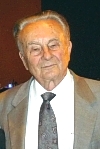
Josef Dadok's
after-dinner talk
was the climax
| Glimpses of the 51st ENC
One month has passed since the 51st ENC (Experimental NMR Conference), which I managed to attend in spite of the ash cloud spilling out from the Islandic volcano with unpronounceable name (Eyjafjallajökull). My journey there and back was actually quite uneventful. Were it not for the fact that some 10% of registered European participants did not make it, the grave absence of the Italian Caffé in the Stelar booth, and the scary stories of my friends, I would have not even noticed there was a problem. Even with so many Europeans missing, the participants were almost 1000.
The week-long meeting was held this year in the Ocean Center Auditorium at Daytona Beach, Florida, and in the Hilton across the Atlantic Avenue. As usual, it was Great. I find it hard to come up with anything critical, except strictly personal items. Like the weather being too hot for my wardrobe (fortunately the "vendors" were handing out light t-shirts). Or like the pub next-door advertizing "we serve them naked (chicken wings, of course)" and the titillating bird view from my room into the outdoor Jacuzzi - both points rubbing in the disappointing fact that I am nearly 70. Or like the Soviet-style architecture of the Hilton sitting right on the beach, something I have always fought. So, personally I find the Asilomar grounds more human, but that has nothing to do with the Conference.
The Conference itself, despite its respectable size, is always pleasant. I can't think of another adjective to describe it. I wonder whether it is because NMR people have to fight for their data with Nature itself and therefore respect each other more than other professions (I know what I am talking about since a week later I was in Stockholm at the six times bigger ISMRM/ESMRM meeting teaming with medicinemen ...). Or maybe it is due to the lucky and age-tested format of the ENC meeting. Or to the team of stable and experienced organizers (meaning Cindy and Jennifer). Or the visibility given to the vendors and their hospitality suites. Or, more likely, the combination of all these factors. Whatever the reason, since I met a lot of old friends and made a number of new ones, I could not be more satisfied and am looking forward to the 52nd edition.
I will not go into a detailed account of the Conference program since it is available on the Conference site and since I was too lazy to attend the talks as assiduously as last year (oops). As always, the program covered all the front-line areas of NMR, as well as novel technical aspects of MRI. The volcano-induced absence of some of the European speakers was admirably covered-up by modern technology. It was the first time I saw remote, intercontinental live presentations (including questions and answers!), which somehow boosted my secret faith in the existence of remote spin radiation :-)
One thing I must mention is the after-the-banquet talk by Josef Dadok (Joe). He strolled through his life dedicated almost entirely to NMR instrumentation, from the origins in Brno, Czechoslovakia (now Czech Republic) where he designed what became the eastern-block 80 MHz instrument series (over 500 were produced by the now defunct Tesla np), through the emigration to the USA after the Soviet invasion of Czechoslovakia, his long collaboration with Axel Bothner-By at Carnegie Mellon Institute where he built the world's first 600 MHz instrument, and other achievements like the rapid-scan spectroscopy technique (now revived in MRI under the name SWIFT). Since many of his personal destinies match my own (my birth town Olomouc is close to Brno) I was deeply touched, but he evidently captured the entire audience by his wit and modesty and earned a standing ovation. He promised to come again next year - possibly with new results.
-----------------------
Finally, allow me to mention my own modest contributions to the Conference which consisted of two posters and a talk at the pre-conference User Meeting of Mestrelab, the guys with whom I have a lot of fun writing software for NMR spectra evaluation. I was pleased to see that this year the buzz word in spectroscopic software was Global Spectral Deconvolution (GSD) which we introduced at the ENC a year ago. While GSD is now becoming a routine tool and spreading into applications and techniques such as metabolomics and DOSY, my talk regarded a new project in which GSD also plays a central role, namely the Automatic Structure Verification (ASV).
Due to lack of time (the volcano did hit my timetable a bit after all) I could not prepare properly a third poster, regarding the formulation of nuclear magnetization as a field (much like the thermal field), an idea which could be useful to describe magnetization evolution in heterogeneous systems. I am now working it out in the form of an article.
|
May 16, 2010
Lorentz Yes,
Gauss No!
For Gauss keeps
the memory of all
the spites I did
to him and, being
low on entropy,
the chance to get
a buck from him
is very very slim.
| Why are spectral lines Lorentzian
Several readers and friends recently wondered why, when it comes to NMR spectroscopy, I clearly privilege Lorentzian lineshapes. Is this not an unjustified limitation? Why not Gaussian or some combination of the two?
These are good questions which do need some reasonable answers. Let me see how I might go about it in the case of NMR spectra of liquids (solid and semi-solid lineshapes can be more complicated) and excluding dynamic effects such as chemical exchange. Just plain HR-NMR spectra. Or any other spectra, such as IR and Raman, for that matter. The entry is tentative, of course; for the benefit of students, those of you who could do it better are invited to contribute.
We believe that the spectral lines of a totally isolated quantum system would be infinitely sharp (delta functions). However, this is not a realistic situation. Real systems are never isolated because, as a minimum, they always interact with the ever present thermal electromagnetic radiation. In condensed phases (liquids, solids) they also interact with each other and, in principle, with any object in the Universe. Finally, one must consider also the interaction between the system and the detector - after all, one can not even observe an isolated system without violating its isolation!
It is always possible to describe the situation by separating the Hamiltonian of a real system into two parts - the time-averaged, static Hamiltonian, and the time-dependent Hamiltonian whose time-average is zero. The static Hamiltonian, when all the real-world interactions are included, leads to a set of quantum levels and transitions which may be many times those of an isolated system. However, they are usually tightly grouped around the isolated system's transitions, forming peaks which need not be resolved. This kind of line broadening is said to be inhomogeneous.
But I guess that inhomogeneous broadening is not what worries my friends, so let us see the role of the time-dependent part of the Hamiltonian. In NMR of liquids, for example, it is usually dominated by the large (tens of kHz) dipole-dipole interactions which depend upon molecular orientation and average to zero. In the fast tumbling limit, when tumbling correlation times are much shorter than relaxation times, such interactions "average out" but they still have an observable (secular) effect on the spectra: they cause non-radiative relaxations and they broaden the spectral lines. This kind of broadening is called homogeneous since it can not be reduced to an envelope of distinct quantum transitions.
A theoretical analysis of the above situation (I will carry it out elsewhere) leads to the understanding that the shapes of inhomogeneously broadened spectral lines are Fourier transforms (FT) of the time-correlation functions of the time-dependent parts of the Hamiltonian. So, if there exist Hamiltonian terms of the type Wi(t), with <Wi(t)>t = 0, then the homogeneously broadened lineshapes are linked to the FT of terms like Cij(τ) = <Wi(t)Wj(t+τ)>t, where <...>t indicates the average over time t. This is also the reason why the Fourier transforms of Cij(τ) are called spectral densities.
The above implies several things. First, relaxations and lineshapes are closely related (well, everybody knows that) and, as far as quantum theory is concerned, they are all second-order effects since in the first order they average to zero.
Second, and this is pertinent to the starting questions, while the transient functions Cij(τ) can in principle have any form, there exists an ideal form which is the exponential decay. However, the use of the term ideal in this context requires an explanation:
An exponentially decaying function C(τ) = C(0)exp(-rτ) satisfies the equation dC(τ)/dτ = -rC(τ). In other words, at any moment τ the evolution of C depends only on the constant parameter r and on the current value of C itself. This is a situation referred to as memory-less behavior: C evolves as though it had no "memory" of any of its previous states. Exponential functions are prototypes of first-order memory-less evolutions and, in a sense which goes beyond the scope of this explanation, they are the only purely memory-less transient decays.
Combining the above statements and considering that the Fourier transform of an exponential decay is a Lorentzian (its half-height linewidth is r/π), we see that considering only Lorentzian lineshapes is equivalent to insisting on memory-less, exponentially decaying correlation functions for the time-dependent components of our Hamiltonians.
Is such an insistence reasonable? Well, yes and not. Unless one has a particular physical model implying a different lineshape, the exponential decay is the most one can do and avoid remaining stuck. In a sense, it is the least compromising assumption reflecting the ignorance of anything more specific. Or, if you want to make it sound more fancy, it is a kind of maximum entropy assumption (maximum entropy == maximum ignorance). Apart from this, it is an empirical fact that Nature itself apparently does the same, no doubt due to the superposition of an enormous number of random interactions whose correlation functions get mixed in an inextricable way.
Let me now add a word about the Gaussian lineshape. To justify it, the correlation functions C(τ) would themselves have to be Gaussian and therefore far from memory-less. While this could happen, it would require a very specific model of molecular dynamics which, at least in liquids, definitely does not apply (neither in solids, really, but that is a different story). Since for small τ the functions C(τ) generally exhibit a constant-rate of decoherence and therefore a cuspid at τ = 0, Gaussian lineshapes have no place anywhere in spectroscopy unless they are introduced artificially (such as through Lorentz-Gauss apodization). It is also not a chance that the convolution of two Loretzians is again a Lorentzian, just like the convolution of two Gaussians is again a Gaussian. Consider, for example, the transitions in a quantum system whose quantum levels have finite widths with Lorentzian profiles. Then, in virtue of the convolution property, a transition between two such levels will also have a Lorentzian lineshape - a fact which implies full coherence between Hilbert- and Liouville- space descriptions of quantum systems. But it also shows that there is little contact between the Lorentzian and the Gaussian "worlds".
Finally, let me underline that the Lorentzian shape is an idealization and no real spectral line will ever be exactly Lorentzian. In this sense, Lorentzians play the same role in spectroscopy and quantum physics as the Gaussian function does, in virtue of the central limit theorem, in statistics and probability. In these fields you will also never find a real probability density function (pdf) which is exactly Gaussian, yet the Gaussian pdf plays a very prominent role. Likewise, there are idealized physical systems which are of paramount importance in physics even though they do not have any exact counterpart in reality: the two best examples are the ideal gas with its ideal thermodynamic state equation and the perfect black body with its Planck's radiation law. Studying such idealized categories is always a prime intellectual experience and never a loss of time.
For further, more NMR oriented details, see the talk Peak Shapes in NMR Spectroscopy.
|
May 15, 2010
| Varian => Agilent: a never-ending story ENDED!
Wow! As soon as I write something like the previous entry, the reality undercuts my legs! Today I found my e-mail totally clogged by messages from friends, as well as 16 (!) automatic RSS messages from Varian regarding the fact that the acquisition of Varian Inc by Agilent Technologies is now a reality. Yesterday it got the FTC approval and immediately Varian moved to withdraw its stock from the stock exchange and issued all the notices which the US law requires to be made public.
If somebody at the last ENC defined me a "slippery spy" (jokingly, I hope), this shows beyond any doubt that I just could not make a living in that trade. I will retreat back to physics and never do any slippery spying again, I promise (well, kind of).
Now that Varian Inc is wholly owned by Agilent Technologies (and so is, by implication, the once independent Magnex in the UK), it remains to be seen what exactly Agilent will do with it. I sure hope that Bruker will get something to ponder. Not that I have anything against Bruker; I was one of them and sure the old, charismatic Gunther Laukien did a lot of good for the whole European instrumentation industry, but competition is healthy and there is never enough of it!
|
May 13, 2010
Previous entries:
January 2010
July 2009


| Varian => Agilent: a never-ending story
To continue writing about the pending Varian - Agilent "merger" is becoming a bit repetitive for a blog. Yet a lot is at stake, especially in the NMR spectroscopy area, and Agilent is strangely silent about their intentions once the bureaucratic aspects of the operation are over, except for the generic statement on page 4 of the Form 10-K SEC filing of October 2 ("Varian will survive the merger and continue as a wholly owned subsidiary of Agilent"). A silence which, in my opinion, starts hurting Varian Inc analytical instrumentation business, no matter under which logo it will be continued (all the Varian guys are convinced that it will indeed be continued, but that's exactly what Agilent is silent about). Hence, a brief update:
The announced "merger" has been for months in deep freeze, pending the decision of the Federal Trade Commission (FTC) and Securities Exchange Commission (SEC). As reported in a previous entry, the EU authority gave a conditional approval on January 20. The EU authorities required Varian to divest some of its business prior to approving the merger. Following a Bruker - Agilent agreement, Varian did so, announcing on March 10 the sale of three analytical instrumentation branches (not NMR). The operation caused some rumors since the buyer was Bruker Corporation's US subsidiary - exactly the Company which should be one of the Agilent's principal competitors in the analytical instrumentation trade. Some observers even speculated that the EU authorities had been fooled and the two Companies are drifting towards an undesirable "cozy" relationship. While this does not seem to be the case, what really is the case remains unclear.
Trading in Varian Inc stock is artificially frozen; since the first merger announcement in July 27 last year, its value is nailed to the $51.8 line and the VARI trading graph resembles a dead man's encephalogram. I have never seen anything like that going on for such a long period.
There were three more recent developments:
1) A Form 8-K SEC filing of April 23 extends the "End Date" of the "merger" from end of April to July 25. In less official documents, both Varian and Agilent expressed hope that the "merger" would be completed by "beginning of May or, at the latest, mid of May", a term which almost certainly will be missed again.
2) On May 12 (yesterday) Varian Inc made public its quarterly balance which is not too bad - sales and earnings are down a bit compared with the same period of 2009, but not more so than what one might expect in the currect economic crisis.
3) A Form 8-K SEC filing, also of May 12, states that the conditional character of the EU approval has been removed, while the FTC approval is still pending and there is no word of any expected end to the odyssey. Also, this filing clearly puts the "merger" in quatation marks but spells it out as acquisition of Varian, Inc. by Agilent Technologies, Inc. Consequently, I follow the same approach.
Finally, allow me some personal gossip. Varian was exhibiting both at the ENC (Daytona Beach, Florida, April 18-23) and the ISMRM-ESMRM (Stockholm, May 3-7) meetings.
At ENC I had an impression that a couple of days into the conference Varian people became kind of euphoric, so I thought that maybe some internal clarification had taken place. In any case, a couple of Agilent CEO's were present, too, though they kept a low profile and did not carry badges. I was presented to one as if to say "you see, they care" and got the impression that they indeed do.
At ISMRM Varian had a stand dedicated to their small-bore MRI systems. I talked to a Varian CEO there and he first pretended he never heard about Agilent, then had to change the story but claimed that a merger was something in a distant future, then reduced the "distant" to next November, and finally entered the "no comment" mode. Sincerely, I am curious about this: while the Varian Inc analytical bussiness fits Agilent's current lines - and so does the Varian vacuum technology for semiconductor industry - MRI would be something totally new for Agilent. Are they going to keep it? Well, ok, they won't tell.
|
May 9, 2010
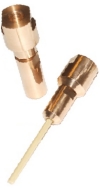
High pressure
NMR accy

Breast MRI coil
+ biopsy

EEG - fMRI
| An update on Companies and Books
Having participated in two recent Conferences (the 51st ENC and a stint at ISMRM-ESMRM), I am again badly behind my "plan" with this blog. Hopefully, it will improve now since there is not much going on in May but regular work. To start with, I have taken advantage of the information collected at the two Meetings and made a major overhaul of the lists of MR Companies and NMR, ESR & MRI Books. It took a whole day, but it was worth it since there is so much going on in these areas, especially in MRI. I will return to some of these developments in the next days; now just briefly:
Companies:
In traditional NMR I have listed only one new Company. It is Daedalus Innovations, offering an accessory for high pressure NMR, developed to do reverse micelle studies. The latter is a technique of encapsulating large bio-molecules into water micelles and dissolving the latter in a non-polar pressurized solvent in order to increase the mobility of the system and thus reduce the linewidths. These probes could have a much wider use, though. I remember a discussion I had years ago with a friend (Giovanna Barbarella) who pressed on me the potential advantages of doing NMR in super-critical solvents (such as SO2). The availability of the hardware might yet revive this technique.
Something that catched my fancy is a significant progress in cryogen-free magnet technology which is rapidly approaching the high-resolution, high-field NMR region. There are at least three Companies operating in this area (not mentioning the big ones who are sure working on it but will not tell) and it excites me enough to return to it in more detail very soon.
In MRI there is a lively activity indeed: I have added a dozen new Companies, mostly manufacturers of MRI coils and phantoms. While I saw few surprises in whole scanners (except that everything is presumably becoming better and faster etc), there are two thematic areas which are approaching industrial maturity in the sense of emerging specialized manufacturers: one is interventional MRI (such as breast coils allowing contextual biopsy) and the other is the EEG-fMRI combination of electro-encefalography with functional MRI (to this I will also return later).
An exhortation: when I say "new" company, I mean new to the list. Some of these companies existed since years but I was not aware of them. Manufacturers of anything relevant to Magnetic Resonance, please check my entries for correctness and, above all, if you are not listed, let me know. The listing is gratuitous and the list is intended as a service to the whole community. Several manufacturers told me they see a lot of visits originating from the page. Since I am neutral and do not wish to discriminate anybody, don't hesitate to claim your own one-liner in the list. Should you want to add a payed banner, I would be glad (maintaining this site takes a lot of effort) but that is optional.
While checking the links I have also found and deleted a couple of defunct entries which are no longer present on the Internet. Both were Israeli companies which reinforces my impression that in Israel small companies spring up and soon disappear again more often than elsewhere. But it could be just a statistical quirk, of course.
Another feature I must mention is the annoying tendency of some very large Corporations to overhaul their web sites every time a top manager changes, meaning more or less every three months. It is like behemoths plowing clumsily through the cyber-space and leaving thousands of broken links in their wake. I wish they stopped doing it. And it is not just Siemens, I can tell you :-))
Books:
While traditional NMR and EPR publishing is proceeding at a more or less constant pace (some new announcements but not much reaching the market), MRI publishing is going through a true frenzy. It is only May and I already count 37 titles that should become available in 2010, of which 19 already on the market! And by far not all of them are medical - there is enough also for technicians, engineers, programmers and physicists (follow the black titles in the list).
If in mid 2006 I wrote that MRI publishing activity might be surpassing traditional NMR, by the end of 2007 it was already double and this year new MRI titles might beat new NMR+ESR titles by a factor of four. Let us wait and see!
Much as I would like to comment individually on some of the books, they are just too many, and in most cases I am not competent to do so anyway. Please have a look at the product descriptions and reviews published on Amazon (if you order one of the titles after entering Amazon from any of my pages, you will actually contribute a bit to the maintenance of this site).
|
April 11, 2010
COMMENTS: 3

| "Metabolomics" of NMR solvents
My readers can testify, I think, that so far I had been a nice guy, criticizing little, maintaing a constructive attitude and leaning towards positive thinking. Well, maybe I was overdoing it and things might change a bit from now on. In this entry I want to face a very common feature of all NMR spectra that come my way, which is just dirt! And, in case you wonder, yes, the title is an ironic joke.
Together with the Mestrelab guys, I was recently working like hell on ASV (Automatic Structure Verification) and, of course, part of it is solvent recognition, since unless one teaches the wizard to isolate the solvent peaks, it will be happy to verify just the solvent rather than the dissolved compound. I was already suspicious of many (if not most) of the spectra coming my way from different sources. So I have finally decided to have a few "pure" solvents measured in a routine way in a routine lab, equipped with a routine 500 MHz spectrometer. I needed those data not just to check my suspicions but also to extract the solvent parameters because none of the available NMR solvent databases lists them all (more about this another time).
In the enclosed document I have edited what I got for three of the most common solvents (there were more solvents measured, but none was much better). Have a look at it and judge for yourself!
Thereafter, please go to YOUR lab and run a few solvents with nothing added, just to see what's inside. And preferably do it once a month - or at least before you measure any spectra that might ever reach me. Because next time I might start reporting names and addresses :-)
Well, I am kidding, really. But applying GSD (Global Spectrum Deconvolution) to what I was told was a "pure" DMSO spectrum, it reported 64 peaks instead of the expected 24 (19 for the solvent and 5 for the TMS reference). So what is a poor programmer like me supposed to do about it !? And that was one of the best cases: in "pure" methanol spectrum GSD counted 343 peaks, including some very fancy multiplets indeed like the one shown in the 0.04 ppm wide cut-off on the left.
COMMENTS:
30 Apr 2010: Roberto Gil, Carnegie Mellon University
Hi Stan, ... I've just visited your blog and seen the spectrum you show in the last entry entitled "Metabolomics" of NMR solvents. I think that that peak is a badly shimmed THF peak. The CH2's of THF appear at 3.58 and 2.5 ppm. The molecule is symetrical and the CH2's form an AA'XX' high order system, in which you also see virtual couplings. The MeOH you used seems to be a poor quality one or from a bottle that someone has contaminated with THF.
Cheers, Roberto
6 May 2010: Adele Mucci, University of Modena (Italy)
Hi Stan, I red your "Metabonomics of NMR solvents". Have you verified if when you detect your 1.25 ppm pseudo-singlet you also detect the high field triplet at about 0.8 ppm? If your answer is yes the 1.25 ppm singlets is a pseudo-singlet of linear hydrocarbons (vaseline).
Bye, Adele
7 May 2010: Philip J.Sidebottom, GlaxoSmithKline
Stan, I have looked at your spectra and my conclusion is that what you are seeing is the signal for the CH2's in a long chain fatty acid (possibly esterified). This would also explain the triplets at ~ 0.8 and ~ 2.3 ppm and the multiplet at ~ 1.5 ppm.
Philip
15 May 2010: Stan
Thanks to everybody for all the interesting hints. Please, continue writing me; after three months, I will try to make a synthesis of the comments. And yes, Roberto, I am sure that the bottle was contaminated, but I still miss the why's and how's. The point is that if it could happen in one place, it might be a more common situation than what many think (especially students).
|
April 1, 2010
| Magnetic Resonance Master Equation unveiled!
News from orbit: The team of researchers at the International Space Station Alpha has just announced that, thanks to a clever combination of microgravity and prime Russion vodka, they have discovered the ultimate formula for Magnetic Resonance which closes in a definitive way the half a century old controversy about whether Magnetic Resonance involves radiation or just fakes to involve it.
This unique breakthrough in mathematical physics is bound to profoundly affect all our lives. A manager at the EU CERN facility in Switzerland (name withheld) suggested that the equation will help scientists to unlock the mystery of the Birth of our Universe (especially in its first trillionth of a picosecond) and thus pave the way towards a full understanding of the very Nature of Life and, last but not least, a Cure for Cancer. Amazingly, the formula can be cast as just half a page of mathematical symbols. Here it is:

Equally surprising is the fact that the proof of the Master Equation has always been just two mouse clicks away. You can do it yourself: just visit the Inverse Graphing Calculator site and type Magnetic Resonance into its edit box (actually, I have already done it for you).
Signed: Loof Lirpa
|
|
Archive
| For a complete list of all entries since 2005, see the running INDEX
|
|
Visitor #

ADVERTISE with us
NMR, MRI, ESR, NQR
Companies
Societies
Centres & Groups
Journals & Blogs
References
Free Texts
History
Links
BOOKS Lists
MATH | SOFTWARE
PHYSICS | CHEMISTRY
ELECTRONICS | DSP
WWW | Patents+IP
SPECTROSCOPY
MRI | NMR | ESR
Instruments
ARTICLES
Scalar relaxation
Biography of F.C.Yu
Hebel-Slichter effect
MR Antenna Theorem
NMR Dead Time
One-Page MR Primer
K-space and MRI
S/N Perspectives
OTHER
SI Units |
Dimensions
Physics Constants
Science Links

Support this site!
SHOP from here:
COMPUTERS:
Deals
Bestsellers
Accessories
Calculators
This page is
SPONSORED by:


Random offers:
|